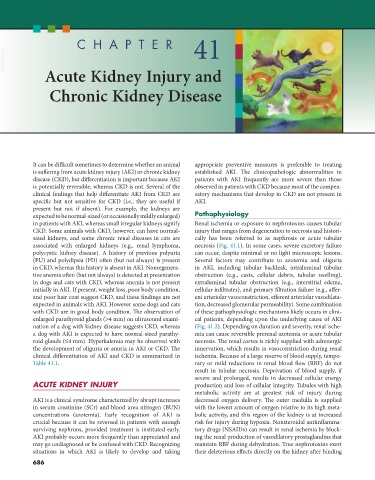Page 714 - Small Animal Internal Medicine, 6th Edition
P. 714
686 PART V Urinary Tract Disorders
CHAPTER 41
VetBooks.ir
Acute Kidney Injury and
Chronic Kidney Disease
It can be difficult sometimes to determine whether an animal appropriate preventive measures is preferable to treating
is suffering from acute kidney injury (AKI) or chronic kidney established AKI. The clinicopathologic abnormalities in
disease (CKD), but differentiation is important because AKI patients with AKI frequently are more severe than those
is potentially reversible, whereas CKD is not. Several of the observed in patients with CKD because most of the compen-
clinical findings that help differentiate AKI from CKD are satory mechanisms that develop in CKD are not present in
specific but not sensitive for CKD (i.e., they are useful if AKI.
present but not if absent). For example, the kidneys are
expected to be normal-sized (or occasionally mildly enlarged) Pathophysiology
in patients with AKI, whereas small irregular kidneys signify Renal ischemia or exposure to nephrotoxins causes tubular
CKD. Some animals with CKD, however, can have normal- injury that ranges from degeneration to necrosis and histori-
sized kidneys, and some chronic renal diseases in cats are cally has been referred to as nephrosis or acute tubular
associated with enlarged kidneys (e.g., renal lymphoma, necrosis (Fig. 41.1). In some cases, severe excretory failure
polycystic kidney disease). A history of previous polyuria can occur, despite minimal or no light microscopic lesions.
(PU) and polydipsia (PD) often (but not always) is present Several factors may contribute to azotemia and oliguria
in CKD, whereas this history is absent in AKI. Nonregenera- in AKI, including tubular backleak, intraluminal tubular
tive anemia often (but not always) is detected at presentation obstruction (e.g., casts, cellular debris, tubular swelling),
in dogs and cats with CKD, whereas anemia is not present extraluminal tubular obstruction (e.g., interstitial edema,
initially in AKI. If present, weight loss, poor body condition, cellular infiltrates), and primary filtration failure (e.g., affer-
and poor hair coat suggest CKD, and these findings are not ent arteriolar vasoconstriction, efferent arteriolar vasodilata-
expected in animals with AKI. However some dogs and cats tion, decreased glomerular permeability). Some combination
with CKD are in good body condition. The observation of of these pathophysiologic mechanisms likely occurs in clini-
enlarged parathyroid glands (>4 mm) on ultrasound exami- cal patients, depending upon the underlying cause of AKI
nation of a dog with kidney disease suggests CKD, whereas (Fig. 41.2). Depending on duration and severity, renal ische-
a dog with AKI is expected to have normal-sized parathy- mia can cause reversible prerenal azotemia or acute tubular
roid glands (≤4 mm). Hyperkalemia may be observed with necrosis. The renal cortex is richly supplied with adrenergic
the development of oliguria or anuria in AKI or CKD. The innervation, which results in vasoconstriction during renal
clinical differentiation of AKI and CKD is summarized in ischemia. Because of a large reserve of blood supply, tempo-
Table 41.1. rary or mild reductions in renal blood flow (RBF) do not
result in tubular necrosis. Deprivation of blood supply, if
severe and prolonged, results in decreased cellular energy
ACUTE KIDNEY INJURY production and loss of cellular integrity. Tubules with high
metabolic activity are at greatest risk of injury during
AKI is a clinical syndrome characterized by abrupt increases decreased oxygen delivery. The outer medulla is supplied
in serum creatinine (SCr) and blood urea nitrogen (BUN) with the lowest amount of oxygen relative to its high meta-
concentrations (azotemia). Early recognition of AKI is bolic activity, and this region of the kidney is at increased
crucial because it can be reversed in patients with enough risk for injury during hypoxia. Nonsteroidal antiinflamma-
surviving nephrons, provided treatment is instituted early. tory drugs (NSAIDs) can result in renal ischemia by block-
AKI probably occurs more frequently than appreciated and ing the renal production of vasodilatory prostaglandins that
may go undiagnosed or be confused with CKD. Recognizing maintain RBF during dehydration. True nephrotoxins exert
situations in which AKI is likely to develop and taking their deleterious effects directly on the kidney after binding
686

